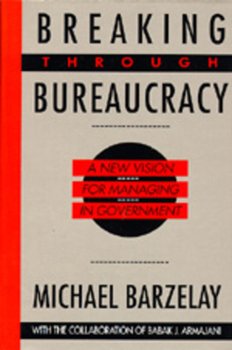Breaking Through Bureaucracy: A New Vision for Managing in Government
Select Format
Select Condition 
Book Overview
This book attacks the conventional wisdom that bureaucrats are bunglers and the system can't be changed. Michael Barzelay and Babak Armajani trace the source of much poor performance in government to the persistent influence of what they call the bureaucratic paradigm-a theory built on such notions as central control, economy and efficiency, and rigid adherence to rules. Rarely questioned, the bureaucratic paradigm leads competent and faithful public...
Format:Paperback
Language:English
ISBN:0520078012
ISBN13:9780520078017
Release Date:October 1992
Publisher:University of California Press
Length:237 Pages
Weight:0.80 lbs.
Dimensions:0.7" x 6.0" x 9.1"
Customer Reviews
2 ratings
Some conceptual and practical keys for systemically addressing typical bureaucratic dysfunctions
Published by Thriftbooks.com User , 17 years ago
At its broadest level, the argument of Breaking Through Bureaucracy is that nothing less than new ways of thinking and acting are required today in public service. The text makes the implicit case that administrators too often have become slave to a set of obsolescent ideas. This text could never have been developed without the interweaving of Babak Armajani's practical experience and Michael Barzelay's theoretical acumen. The argument proceeds on two levels of analysis interwoven throughout the text: 1) the level of ideas through which those with management responsibility typically construct administrative arguments and 2) that of daily administrative operations, most especially with respect to recurring relations between overseers, staff, and line operators. The interweaving of practical and theoretical insights provides invaluable clues for the attentive reader. Part I demonstrates how during the reform era, the bureaucratic paradigm addressed effectively leading problems of its day. At the same time, it argues and illustrates with clarity that yesterday's bureaucratic solutions have become the source of unintended administrative ills and organizational dysfunctions that unnecessarily continue to plague bureaucratic functioning (in government and in business one might add) today. While this case study focuses entirely on governmental operations, its lessons for business are no less profound. Indeed, a colleague of mine restructured his business division after reading this text. It provides practical insight into principles of quality management that correspond with Deming's notion of profound knowledge, not readily available elsewhere. Part I introduces the two main levels of analysis on which the book unfolds. The first level of analysis is that of ideas with which administrators typically frame issues of public management. At this level of analysis, the text sets up a debate, broadly between defenders of the status quo who see recurring troubles along the overseer-staff-line relations as conditions to be endured and possibilist thinker-doers who see these recurring troubles as problems to be solved. At its second level of analysis, the text begins to introduce the reader to concrete routines, constraints, and incentives that typically govern relations between overseers, staff, and line in everyday administrative operations. At this level of analysis, the text argues the need for innovative strategies capable of effectually altering these recurring routines. A principle finding at this concrete level of administrative analysis is articulating how the role of staff (those administrative experts who control inputs to line whether in budget, finance, purchasing, HR, IT etc.) typically constitute likely recurring bottlenecks in government agencies (or any other type of bureaucratic organization) that seek to strengthen responsiveness to customers and to develop a results-oriented culture. Part II of the text presents a case study
Well thought out.
Published by Thriftbooks.com User , 23 years ago
This book is for those of you who are sick of redundant and mundane bureaucratic routine work, and wan to learn about the ways to change such system. This books points out inefficiencies of bureaucracy and promotes the idea of simple and quick approach to technology, which the way we do things. It also gives some good examples from a few corporations that are being affected by their implementation of rational organizational structure i.e. bureaucratic structure. It's an advocate of creative behavior at jobs regardless of the nature.





